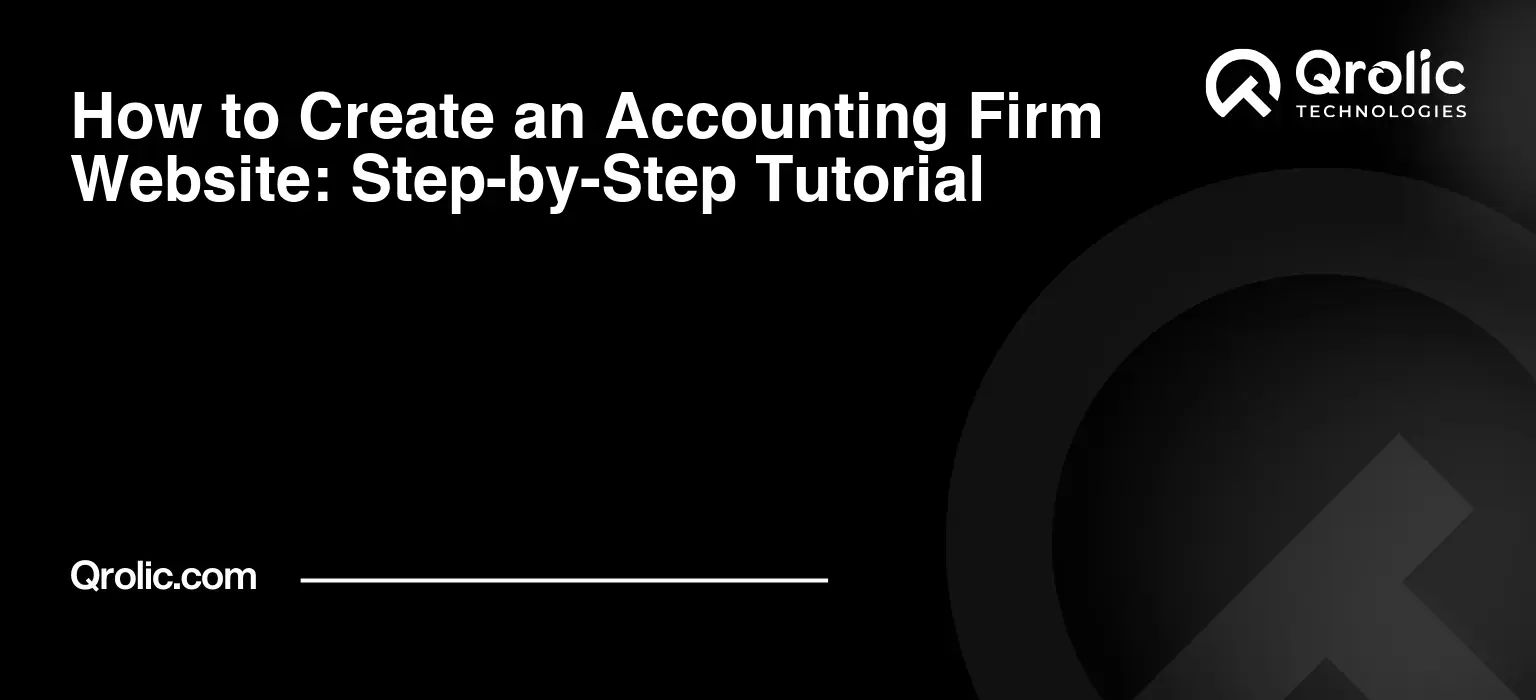Quick Summary:
- Build a strong website to attract clients and establish trust.
- Carefully plan your site and choose the right platform.
- Create great content and optimize it for search engines.
- Maintain your website regularly, or get professional help.
Table of Contents
- Why Your Accounting Firm Needs a Killer Website (And Why It Matters)
- Step 1: Planning Your Accounting Website: Laying the Foundation for Success
- Defining Your Target Audience: Who Are You Trying to Reach?
- Setting Clear Goals: What Do You Want Your Website to Achieve?
- Analyzing Competitors: What Are They Doing Right (and Wrong)?
- Sitemap Creation: Planning the User Journey
- Step 2: Choosing the Right Domain Name and Hosting
- Selecting a Memorable Domain Name: Make It Easy to Remember
- Choosing a Reliable Hosting Provider: Ensuring Your Website Stays Online
- Step 3: Selecting a Website Platform: Choosing the Right Tool for the Job
- WordPress: The King of Content Management Systems (CMS)
- Wix: An Easy-to-Use Drag-and-Drop Website Builder
- Squarespace: A Sleek and Stylish Website Builder
- Step 4: Designing Your Accounting Website: Creating a Professional and Engaging Experience
- Choosing a Professional Theme or Template: Setting the Tone for Your Brand
- Creating a Compelling Homepage: Making a Strong First Impression
- Optimizing User Experience (UX): Making Your Website Easy to Use
- Step 5: Creating High-Quality Content: Providing Value and Establishing Expertise
- Developing a Content Strategy: Planning Your Content Creation
- Writing Engaging Blog Posts: Sharing Your Knowledge and Insights
- Creating Informative Service Pages: Showcasing Your Offerings
- Crafting a Compelling About Us Page: Building Trust and Connection
- Step 6: Optimizing Your Website for SEO: Getting Found Online
- Keyword Research: Finding the Right Keywords to Target
- On-Page Optimization: Optimizing Your Website’s Content and Structure
- Off-Page Optimization: Building Authority and Reputation
- Monitoring Your SEO Performance: Tracking Your Progress and Making Adjustments
- Step 7: Testing and Launching Your Website: Ensuring a Smooth and Successful Launch
- Testing Your Website: Identifying and Fixing Issues
- Launching Your Website: Making Your Website Live
- Step 8: Maintaining and Updating Your Website: Keeping Your Website Fresh and Relevant
- Regularly Updating Your Content: Keeping Your Website Fresh
- Monitoring Website Performance: Tracking Your Success
- Security Updates: Protecting Your Website from Threats
- The Power of Professional Help: When to Call in the Experts
- When DIY Isn’t the Best Option: Recognizing Your Limitations
- What a Web Design Agency Can Offer: Expertise and Results
- Qrolic Technologies: Your Partner in Digital Success
- Final Thoughts: Your Website is an Investment, Not an Expense
Why Your Accounting Firm Needs a Killer Website (And Why It Matters)

Let’s face it: the accounting world isn’t exactly known for its dazzling online presence. But in today’s digital landscape, a strong website isn’t just an option; it’s a lifeline. Think of it as your 24/7 salesperson, constantly working to attract new clients, build trust, and showcase your expertise.
The Client’s First Impression Matters (A Lot)
Imagine a potential client searching for “accountants near me.” What happens when they click on your website? Is it a modern, professional portal that screams competence and reliability? Or is it a dated, clunky eyesore that sends them running to your competitor? First impressions are everything, and your website is often the first impression you make.
Beyond the Brochure: A Website That Works for You
A well-designed accounting firm website isn’t just a pretty face; it’s a powerful tool that can:
- Generate Leads: Attract potential clients with valuable content and clear calls to action.
- Build Credibility: Showcase your expertise, experience, and client testimonials.
- Save Time: Answer frequently asked questions and provide self-service resources.
- Boost Your Brand: Establish a consistent brand identity and differentiate yourself from the competition.
- Improve Client Communication: Offer secure portals for document sharing and communication.
- Increase Efficiency: Automate tasks like appointment scheduling and online payments.
The Cost of NOT Having a Great Website
Think about the potential clients you’re losing because your website isn’t up to par. You might be the best accountant in town, but if your online presence doesn’t reflect that, you’re missing out on opportunities.
Step 1: Planning Your Accounting Website: Laying the Foundation for Success
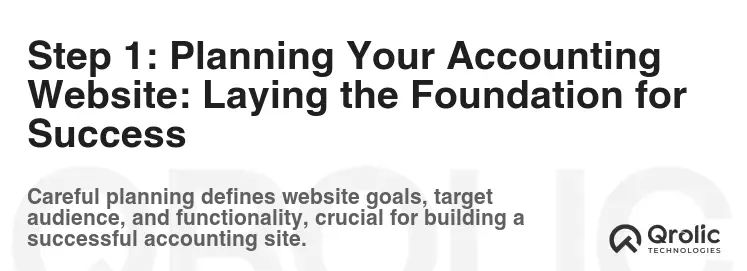
Before you even think about choosing a domain name or picking a color palette, you need a solid plan. This is where you define your goals, target audience, and the overall message you want to convey.
Defining Your Target Audience: Who Are You Trying to Reach?
Are you targeting small business owners, startups, high-net-worth individuals, or a specific industry? Understanding your target audience is crucial for tailoring your website content and design.
- Identify Your Ideal Client: Create a detailed profile of your ideal client, including their demographics, needs, and pain points.
- Research Their Online Behavior: Where do they spend their time online? What keywords do they use when searching for accounting services?
- Tailor Your Messaging: Use language and imagery that resonates with your target audience.
Setting Clear Goals: What Do You Want Your Website to Achieve?
What do you want visitors to do when they land on your website? Do you want them to:
- Request a Consultation?
- Download a Free Guide?
- Sign Up for Your Newsletter?
- Learn More About Your Services?
Define specific, measurable, achievable, relevant, and time-bound (SMART) goals for your website. This will help you track your progress and make adjustments as needed.
Analyzing Competitors: What Are They Doing Right (and Wrong)?
Take a look at your competitors’ websites. What do you like about them? What could be improved? Don’t copy them, but use their websites as inspiration and identify opportunities to differentiate yourself.
- Identify Your Key Competitors: Make a list of accounting firms that compete with you in your target market.
- Analyze Their Websites: Evaluate their design, content, SEO, and user experience.
- Identify Opportunities to Differentiate: What can you do better than your competitors? What unique value proposition can you offer?
Sitemap Creation: Planning the User Journey
A sitemap is a visual representation of your website’s structure. It outlines the different pages and how they are connected. This is crucial for user experience and SEO.
- Essential Pages:
- Homepage: The first impression.
- About Us: Tell your story and build trust.
- Services: Clearly describe your offerings.
- Team: Introduce your team members and their expertise.
- Blog: Share valuable content and establish thought leadership.
- Case Studies: Showcase your successes.
- Testimonials: Build social proof.
- Contact Us: Make it easy for potential clients to reach you.
- Logical Navigation: Ensure users can easily find what they’re looking for.
- User-Friendly Structure: Keep the number of pages manageable and avoid overwhelming visitors.
Step 2: Choosing the Right Domain Name and Hosting
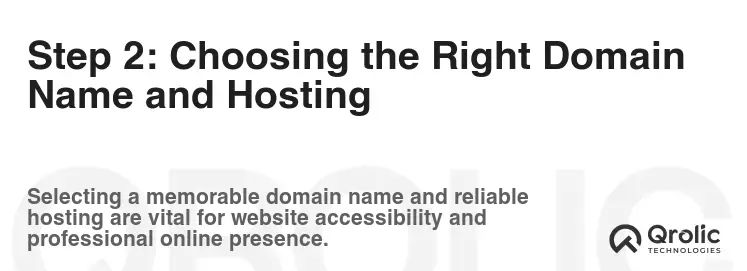
Your domain name is your online address, and your hosting is where your website lives. Choosing the right domain name and hosting provider is crucial for your website’s success.
Selecting a Memorable Domain Name: Make It Easy to Remember
Your domain name should be:
- Relevant: Reflect your brand and services.
- Memorable: Easy to remember and spell.
- Short: Concise and easy to type.
- Available: Check if the domain name is available before you get your heart set on it.
- .com: Ideally, choose a .com domain extension.
Tips for Brainstorming Domain Names:
- Use Your Firm Name: This is the most obvious choice, but it’s not always available.
- Include Keywords: Incorporate keywords related to accounting or your target audience.
- Be Creative: Think outside the box and come up with a unique and memorable name.
Choosing a Reliable Hosting Provider: Ensuring Your Website Stays Online
Your hosting provider is responsible for storing your website’s files and making them accessible to visitors. Choose a reliable provider with:
- Uptime Guarantee: Look for a provider with a high uptime guarantee (ideally 99.9% or higher).
- Fast Loading Speeds: Website Speed is crucial for user experience and SEO.
- Security Features: Protect your website from hackers and malware.
- Scalability: Choose a provider that can accommodate your website’s growing needs.
- Excellent Customer Support: Get help when you need it.
Popular Hosting Providers:
- Bluehost: A popular choice for beginners.
- SiteGround: Known for its excellent customer support.
- WP Engine: A managed WordPress hosting provider.
- Kinsta: A premium managed WordPress hosting provider.
Step 3: Selecting a Website Platform: Choosing the Right Tool for the Job
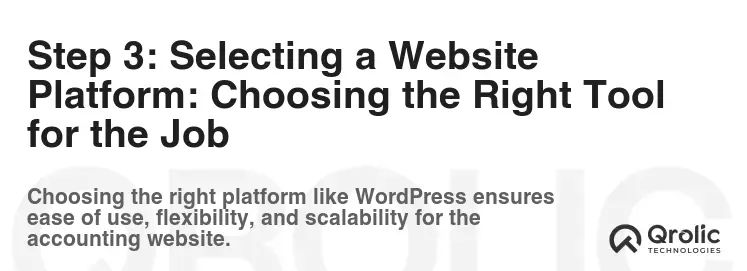
There are several website platforms to choose from, each with its own pros and cons. The most popular options are WordPress, Wix, and Squarespace.
WordPress: The King of Content Management Systems (CMS)
WordPress is the most popular CMS in the world, powering over 40% of all websites. It’s a powerful and flexible platform that offers a wide range of features and customization options.
Pros:
- Flexibility: Highly customizable with thousands of themes and plugins.
- SEO-Friendly: Optimized for search engines.
- Scalability: Can handle websites of all sizes.
- Large Community: Extensive support and resources available.
- Open-Source: Free to use.
Cons:
- Steeper Learning Curve: Requires some technical knowledge.
- Maintenance: Requires regular updates and security patches.
Wix: An Easy-to-Use Drag-and-Drop Website Builder
Wix is a drag-and-drop website builder that’s ideal for beginners. It’s easy to use and offers a wide range of templates to choose from.
Pros:
- Ease of Use: Drag-and-drop interface.
- Variety of Templates: Wide range of professionally designed templates.
- All-in-One Solution: Includes hosting and domain registration.
Cons:
- Limited Customization: Less flexible than WordPress.
- SEO Limitations: Can be less SEO-friendly than WordPress.
- Cost: Can be more expensive than WordPress in the long run.
Squarespace: A Sleek and Stylish Website Builder
Squarespace is another drag-and-drop website builder that’s known for its sleek and stylish designs. It’s a good choice for businesses that want a visually appealing website.
Pros:
- Beautiful Templates: High-quality, modern designs.
- Ease of Use: User-friendly interface.
- All-in-One Solution: Includes hosting and domain registration.
Cons:
- Limited Customization: Less flexible than WordPress.
- SEO Limitations: Can be less SEO-friendly than WordPress.
- Cost: Can be more expensive than WordPress in the long run.
Which Platform is Right for You?
- WordPress: Best for businesses that need a highly customizable and SEO-friendly website.
- Wix: Best for beginners who want an easy-to-use website builder.
- Squarespace: Best for businesses that want a visually appealing website with minimal technical effort.
Step 4: Designing Your Accounting Website: Creating a Professional and Engaging Experience
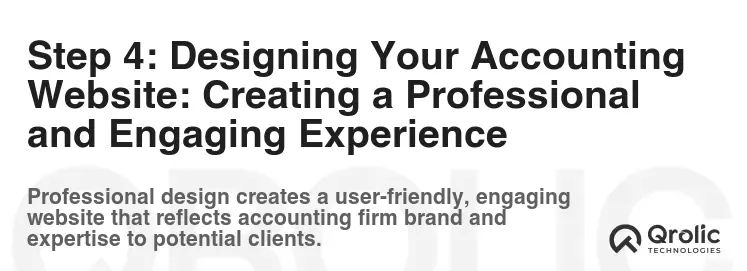
Your website’s design is crucial for attracting and retaining visitors. It should be professional, visually appealing, and easy to navigate.
Choosing a Professional Theme or Template: Setting the Tone for Your Brand
Whether you’re using WordPress, Wix, or Squarespace, you’ll need to choose a theme or template that suits your brand and target audience.
- Professional Design: Choose a theme or template that looks professional and modern.
- Mobile-Responsiveness: Ensure your website is mobile-friendly.
- Customization Options: Choose a theme or template that allows you to customize the colors, fonts, and layout.
- SEO-Friendly: Look for themes or templates that are optimized for search engines.
- Readability: Ensure the text is easy to read.
Tips for Choosing a Theme or Template:
- Browse the Theme Libraries: Explore the theme libraries offered by WordPress, Wix, and Squarespace.
- Filter by Industry: Look for themes or templates that are specifically designed for accounting firms.
- Read Reviews: Check out reviews from other users before making a decision.
- Preview the Theme: See how the theme looks on different devices.
Creating a Compelling Homepage: Making a Strong First Impression
Your homepage is the first page that visitors see, so it’s crucial to make a strong first impression.
- Clear Value Proposition: Clearly communicate what you do and how you can help potential clients.
- High-Quality Images: Use professional images that reflect your brand.
- Clear Calls to Action: Guide visitors to take the next step, such as requesting a consultation or downloading a free guide.
- Easy Navigation: Make it easy for visitors to find what they’re looking for.
- Mobile-Responsiveness: Ensure your homepage looks great on all devices.
Key Elements of a Compelling Homepage:
- Headline: Grab the visitor’s attention with a compelling headline.
- Subheadline: Provide more detail about your services.
- Images or Videos: Use visuals to showcase your brand and expertise.
- Benefits: Highlight the benefits of working with your firm.
- Testimonials: Build social proof.
- Call to Action: Encourage visitors to take the next step.
Optimizing User Experience (UX): Making Your Website Easy to Use
User experience (UX) is all about making your website easy to use and enjoyable for visitors.
- Intuitive Navigation: Ensure your website is easy to navigate.
- Fast Loading Speeds: Optimize your website for speed.
- Mobile-Responsiveness: Ensure your website is mobile-friendly.
- Clear and Concise Content: Write clear and concise content that’s easy to understand.
- Accessibility: Make your website accessible to users with disabilities.
Tips for Improving UX:
- Conduct User Testing: Get feedback from real users.
- Analyze Website Analytics: Track how users interact with your website.
- Use Heatmaps: See where users are clicking and scrolling.
- Simplify Navigation: Make it easy for users to find what they’re looking for.
- Optimize for Speed: Reduce image sizes and use a content delivery network (CDN).
Step 5: Creating High-Quality Content: Providing Value and Establishing Expertise
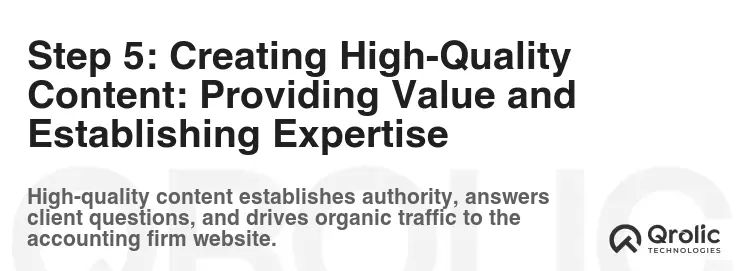
Content is king. High-quality content is crucial for attracting and retaining visitors, building trust, and improving your website’s SEO.
Developing a Content Strategy: Planning Your Content Creation
A content strategy is a plan for creating and distributing valuable, relevant, and consistent content to attract and retain a specific audience.
- Define Your Target Audience: Who are you trying to reach with your content?
- Identify Their Needs and Pain Points: What information are they looking for?
- Choose Your Content Formats: What types of content will you create (e.g., blog posts, articles, videos, infographics)?
- Create a Content Calendar: Plan your content creation and publishing schedule.
- Promote Your Content: Share your content on social media and other channels.
Writing Engaging Blog Posts: Sharing Your Knowledge and Insights
Blog posts are a great way to share your knowledge and insights with potential clients.
- Choose Relevant Topics: Write about topics that are relevant to your target audience.
- Provide Valuable Information: Offer helpful tips and advice.
- Use Clear and Concise Language: Write in a way that’s easy to understand.
- Optimize for SEO: Use relevant keywords and optimize your blog posts for search engines.
- Promote Your Blog Posts: Share your blog posts on social media and other channels.
Blog Post Ideas for Accounting Firms:
- Tax Tips for Small Businesses
- How to Choose the Right Accounting Software
- Understanding Financial Statements
- The Importance of Budgeting
- Common Tax Mistakes to Avoid
Creating Informative Service Pages: Showcasing Your Offerings
Your service pages should clearly describe the services you offer and the benefits of working with your firm.
- Clearly Define Your Services: What specific services do you offer?
- Highlight the Benefits: What are the benefits of using your services?
- Use Case Studies: Showcase your successes.
- Include Testimonials: Build social proof.
- Use Clear Calls to Action: Encourage visitors to contact you.
Crafting a Compelling About Us Page: Building Trust and Connection
Your About Us page is an opportunity to tell your story, build trust, and connect with potential clients.
- Tell Your Story: Share your firm’s history and mission.
- Introduce Your Team: Highlight the expertise and experience of your team members.
- Showcase Your Values: What are your firm’s core values?
- Use High-Quality Images: Include photos of your team and office.
- Make it Personal: Let your personality shine through.
Step 6: Optimizing Your Website for SEO: Getting Found Online
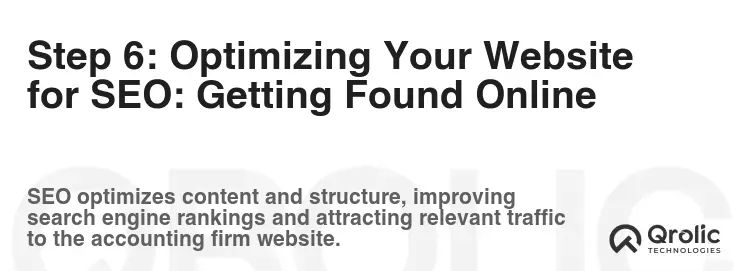
SEO (Search Engine Optimization) is the process of optimizing your website to rank higher in search engine results pages (SERPs). This is crucial for attracting organic traffic to your website.
Keyword Research: Finding the Right Keywords to Target
Keyword research is the process of identifying the keywords that your target audience is using to search for accounting services.
- Brainstorm Relevant Keywords: Think about the keywords that potential clients might use to find your services.
- Use Keyword Research Tools: Use tools like Google Keyword Planner, Ahrefs, and SEMrush to find relevant keywords and their search volume.
- Focus on Long-Tail Keywords: Target longer, more specific keywords that have less competition.
On-Page Optimization: Optimizing Your Website’s Content and Structure
On-page optimization is the process of optimizing your website’s content and structure to improve its ranking in search engine results.
- Use Keywords in Your Titles and Headings: Include your target keywords in your page titles and headings.
- Write High-Quality Content: Create valuable, relevant, and engaging content that is optimized for your target keywords.
- Optimize Your Images: Use descriptive alt tags for your images.
- Improve Website Speed: Optimize your website for speed.
- Use Internal Linking: Link to other relevant pages on your website.
Off-Page Optimization: Building Authority and Reputation
Off-page optimization is the process of building your website’s authority and reputation by getting links from other websites.
- Build High-Quality Backlinks: Get links from reputable websites in your industry.
- Guest Blogging: Write guest posts for other websites in your industry.
- Social Media Marketing: Promote your content on social media.
- Online Directory Listings: List your business in online directories.
Monitoring Your SEO Performance: Tracking Your Progress and Making Adjustments
It’s important to monitor your SEO performance to track your progress and make adjustments as needed.
- Use Google Analytics: Track your website’s traffic, bounce rate, and conversion rate.
- Use Google Search Console: Monitor your website’s search performance and identify any technical issues.
- Track Your Keyword Rankings: Monitor your website’s ranking for your target keywords.
- Make Adjustments Based on Your Findings: Adjust your SEO strategy based on your findings.
Step 7: Testing and Launching Your Website: Ensuring a Smooth and Successful Launch

Before you launch your website, it’s important to test it thoroughly to ensure that everything is working properly.
Testing Your Website: Identifying and Fixing Issues
- Check for Broken Links: Make sure all of your links are working properly.
- Test Your Forms: Ensure that your forms are submitting correctly.
- Test on Different Browsers and Devices: Make sure your website looks and works great on all browsers and devices.
- Check for Spelling and Grammar Errors: Proofread your content carefully.
- Test Website Speed: Ensure your website loads quickly.
Launching Your Website: Making Your Website Live
Once you’ve tested your website and fixed any issues, you’re ready to launch it.
- Point Your Domain Name to Your Hosting Account: Update your domain name settings to point to your hosting account.
- Submit Your Website to Search Engines: Submit your website to Google and other search engines.
- Promote Your Website: Share your website on social media and other channels.
Step 8: Maintaining and Updating Your Website: Keeping Your Website Fresh and Relevant

Once you’ve launched your website, it’s important to maintain and update it regularly to keep it fresh and relevant.
Regularly Updating Your Content: Keeping Your Website Fresh
- Add New Blog Posts: Regularly publish new blog posts to keep your website fresh and engaging.
- Update Your Service Pages: Keep your service pages up-to-date with the latest information.
- Add New Testimonials: Regularly add new testimonials to build social proof.
Monitoring Website Performance: Tracking Your Success
- Track Your Website Traffic: Monitor your website’s traffic to see how it’s performing.
- Analyze Your Website Analytics: Use Google Analytics to track your website’s performance and identify areas for improvement.
- Monitor Your SEO Rankings: Track your website’s ranking for your target keywords.
Security Updates: Protecting Your Website from Threats
- Keep Your Website Platform Updated: Regularly update your website platform (e.g., WordPress, Wix, Squarespace) to the latest version.
- Install Security Plugins: Install security plugins to protect your website from hackers and malware.
- Use Strong Passwords: Use strong passwords for your website and hosting account.
The Power of Professional Help: When to Call in the Experts
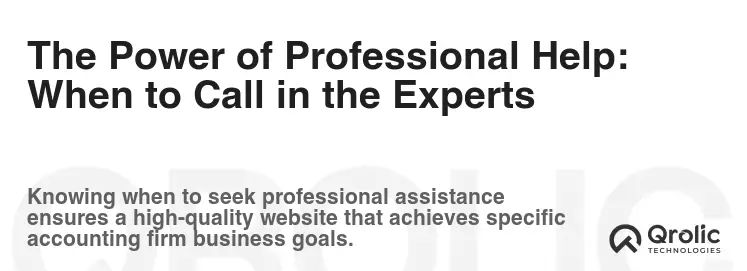
While creating your accounting firm website yourself is definitely possible, there are times when bringing in professional help is the smartest move. Think of it as an investment in your business’s future.
When DIY Isn’t the Best Option: Recognizing Your Limitations
- Lack of Time: Are you already stretched thin managing your clients and firm?
- Limited Technical Skills: Feeling overwhelmed by coding, design, or SEO?
- Desire for a High-End Result: Do you want a truly exceptional website that stands out from the crowd?
- Focus on Core Business: Would your time be better spent on client acquisition and service delivery?
If you answered “yes” to any of these, professional help might be the way to go.
What a Web Design Agency Can Offer: Expertise and Results
A reputable web design agency specializing in accounting firms can provide:
- Custom Design: A unique website tailored to your brand and target audience.
- Technical Expertise: Expertise in coding, design, SEO, and security.
- Project Management: A dedicated project manager to keep things on track.
- Ongoing Support: Maintenance, updates, and technical support after launch.
- Measurable Results: Trackable data and insights to improve your website’s performance.
Qrolic Technologies: Your Partner in Digital Success
Qrolic Technologies is a leading provider of innovative technology solutions for businesses of all sizes. We specialize in crafting custom websites that not only look stunning but also drive measurable results. Our team of experienced designers, developers, and SEO experts understands the unique needs of accounting firms and can help you create a website that:
- Attracts New Clients: We use proven strategies to generate leads and convert visitors into clients.
- Builds Trust and Credibility: We showcase your expertise and establish you as a leader in your field.
- Improves Client Communication: We integrate secure portals for document sharing and communication.
- Streamlines Your Operations: We automate tasks and improve efficiency.
Why Choose Qrolic Technologies?
- Accounting Industry Expertise: We understand the specific needs of accounting firms.
- Custom Solutions: We tailor our services to your unique requirements.
- Proven Results: We have a track record of delivering successful websites.
- Dedicated Support: We provide ongoing support and maintenance.
- Transparent Pricing: We offer competitive and transparent pricing.
Ready to take your online presence to the next level?
Contact Qrolic Technologies today for a free consultation. Let us help you create an accounting firm website that drives growth and success.
Final Thoughts: Your Website is an Investment, Not an Expense

Creating a successful accounting firm website is an ongoing process, not a one-time event. It requires careful planning, execution, and ongoing maintenance. But the rewards are well worth the effort. A well-designed and optimized website can attract new clients, build trust, and ultimately drive growth for your firm. Remember to view your website as an investment in your business’s future. By focusing on providing value to your target audience and creating a user-friendly experience, you can create a website that helps you achieve your business goals.
